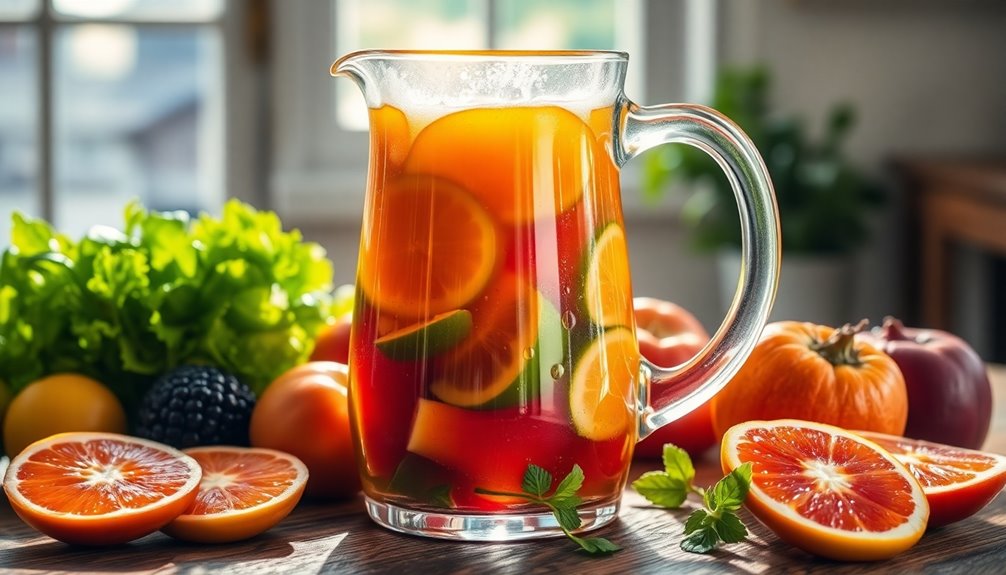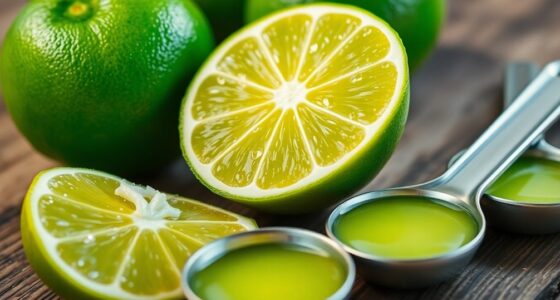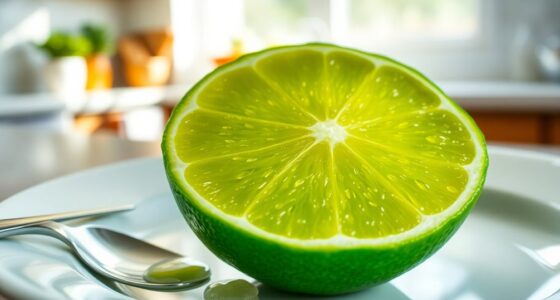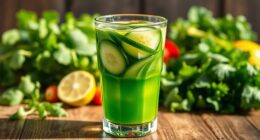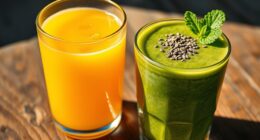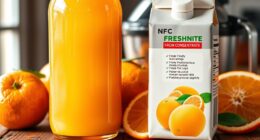Juice from a juicer lasts different amounts of time based on the type you use. If you’ve got a centrifugal juicer, your juice will stay fresh for about 24 hours. Masticating juicers offer a better shelf life, keeping juice good for 48 to 72 hours. For the longest freshness, twin-gear juicers can preserve juice for 4 to 5 days. Want to know how to maximize the longevity and flavor of your juice? There’s more to discover! To maximize the longevity and flavor of your juice, it’s important to store it properly in airtight containers and keep it refrigerated. Additionally, the type of fruits and vegetables you use can impact freshness, as some ingredients are more prone to oxidation than others. If you’re wondering how long can juice stay fresh, remember that minimizing exposure to air and light can significantly extend its shelf life, making your delicious creations last longer.
Key Takeaways
- Juice from a centrifugal juicer lasts up to 24 hours due to higher oxidation rates.
- Masticating juicer juice can last 48 to 72 hours, preserving more nutrients.
- Twin-gear juicer juice remains fresh for 4 to 5 days with minimal oxidation.
- Proper storage in airtight glass containers at 35 to 40°F maximizes juice shelf life.
- Adding acidic ingredients like lemon juice can slow oxidation and enhance flavor.
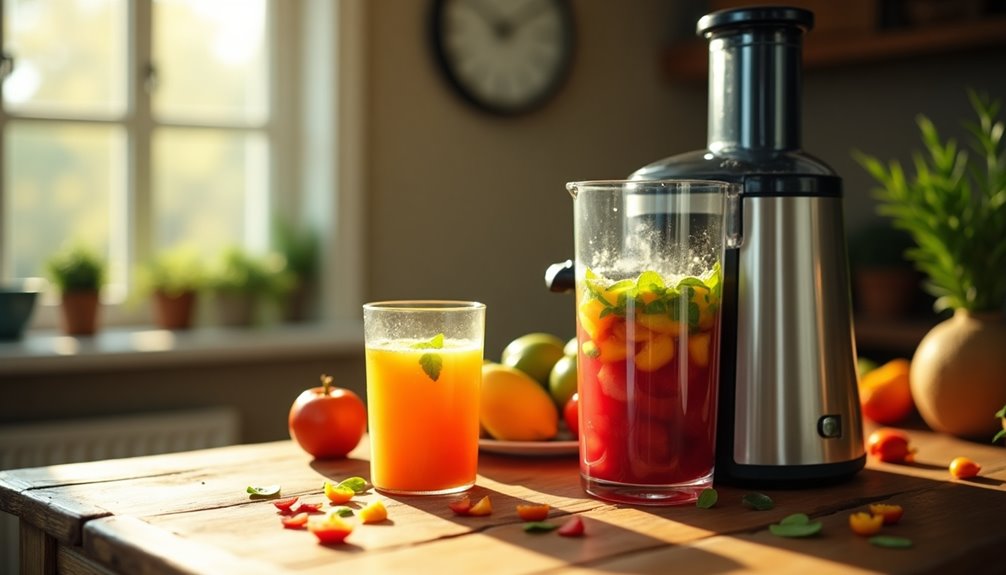
When you whip up a fresh batch of juice, you might wonder how long it'll actually last before it starts to lose its zing. The answer can vary depending on the type of juicer you use and how you store your homemade juice.
If you're using a centrifugal juicer, you should know that juice made from it typically lasts up to 24 hours. This is primarily due to the higher oxidation rates associated with this type of juicer, which introduces more air into your juice and accelerates the deterioration process. So, if you're planning to enjoy your juice over a few days, this mightn't be the best option for you.
On the other hand, if you opt for a masticating juicer, you can extend the shelf life of your juice to around 48 to 72 hours. The masticating juicer's gentle extraction process preserves more nutrients and flavor, allowing your juice to stay fresher for a longer time. This means that if you're serious about enjoying the health benefits of your juice, investing in a masticating juicer could be a smart choice.
For the ultimate in freshness, consider a twin-gear juicer, which can keep your juice fresh for an impressive 4 to 5 days. This type of juicer minimizes oxidation even further, giving you the best chance at enjoying the full flavor and nutritional value over a longer period.
Regardless of the juicer you choose, how you store your fresh juice plays a crucial role in its longevity. It's important to store your homemade juice properly to maximize its shelf life. Using airtight containers is essential; glass containers are often recommended because they not only seal in freshness but also don't leach chemicals like some plastic options may.
Keep your juice in the refrigerator at temperatures around 35 to 40°F (1.6 to 4.4°C) for optimal freshness.
You can also get a bit creative with your ingredients to help extend shelf life. Adding acidic components like lemon juice can slow down the oxidation process, helping to keep your juice vibrant and delicious for a longer time. So, not only does it enhance the flavor, but it also acts as a natural preservative.
Frequently Asked Questions
How Long Do Juices Last After Juicing?
After juicing, you'll find that the longevity of your fresh juice depends on several factors.
Generally, the type of juicer you use plays a big role; for instance, if you're using a centrifugal juicer, your juice might only last about 24 hours.
However, if it's from a masticating juicer, it can last up to 2 to 3 days.
To keep it fresh, store it in airtight containers in the refrigerator.
How to Preserve Juice From a Juicer?
Imagine your fresh juice as a vibrant sunset, slowly fading if not cared for. To preserve that brilliance, store your juice in airtight glass containers; they protect it like a shield.
Fill them to the brim, cutting down on air exposure. Keep it cool in the fridge, around 35-40°F. A splash of lemon juice adds a touch of magic, extending its life.
For longer storage, freeze small portions, capturing the essence of that sunset for months!
Do You Have to Drink Juice Immediately After Juicing?
You don't have to drink juice immediately after juicing, but it's best to enjoy it fresh for maximum taste and nutrients.
If you want to save some for later, store it in an airtight glass container in the fridge. Keeping it at 35-40°F helps maintain its quality.
Adding lemon juice can also help preserve freshness. Just remember, the sooner you drink it, the better the health benefits!
How Long Does Fresh Juice Last in a Mason Jar?
Fresh juice stored in a mason jar typically lasts between 24 to 72 hours in the fridge.
To enjoy the best taste and nutrients, drink it within the first 24 hours. Use an airtight jar to minimize oxidation, and fill it to the brim to reduce air exposure.
Keep the temperature around 35-40°F to inhibit bacteria growth.
If you want to save it longer, freeze it in a mason jar for up to six months.
Conclusion
In the grand scheme of things, freshly squeezed juice doesn't last forever. Ideally, you should enjoy it within 24 hours for the best taste and nutrients. After that, it starts to lose its zing, and you might notice changes in flavor and color. So, if you want to reap the benefits, drink up quickly! Remember, you can't have your cake and eat it too—fresh juice is best consumed sooner rather than later.
Cindy thoroughly researches juicing trends, techniques, and recipes to provide readers with practical advice and inspiration. Her writing style is accessible, engaging, and designed to make complex concepts easy to understand. Cindy’s dedication to promoting the advantages of juicing shines through her work, empowering readers to make positive changes in their lives through the simple act of juicing.

